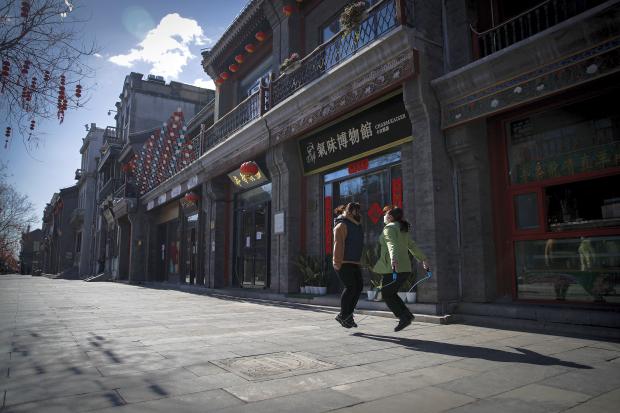
Masked workers jump a rope at a quiet main Qianmen Street, a popular tourist spot, in Beijing, Sunday, Feb. 16, 2020. China reported Sunday a drop in new virus cases for the third straight day, as it became apparent that the country’s leadership was aware of the potential gravity of the situation well before the alarm was sounded. (Photo by ANDY WONG / AP)
BEIJING — A recent speech by Chinese President Xi Jinping that has been published by state media indicates for the first time that he was leading the response to a new virus outbreak from early on in the crisis.
The publication of the Feb. 3 speech was an apparent attempt to demonstrate that the Communist Party leadership acted decisively from the beginning, but also opens Xi up to criticism over why the public was not alerted sooner.
In the speech, Xi said he gave instructions on fighting the virus on Jan. 7 and ordered the shutdown of cities that began on Jan. 23 at the epicenter of the outbreak. His remarks were published by state media late Saturday.
“On Jan. 22, in light of the epidemic’s rapid spread and the challenges of prevention and control, I made a clear request that Hubei province implement comprehensive and stringent controls over the outflow of people,” he told a meeting of the party’s standing committee, its top body.
China’s National Health Commission on Sunday reported a drop in new virus cases for the third straight day. There were 2,009 new cases in mainland China, bringing the total to 68,500.
The mortality rate remained stable with 142 new deaths, the commission said, raising the death toll from COVID-19, a disease caused by a new coronavirus, to 1,665. Another 9,419 people have recovered and been discharged from hospitals.
Four people have died outside of mainland China, with the most recent fatalities in France and Japan last week.
About 400 Americans on a quarantined cruise ship in Japan were awaiting charter flights home, as Japan announced another 70 infections had been confirmed on the vessel. Canada and Hong Kong said they were planning similar flights.
Xi’s role was muted in the early days of the epidemic, which has grown into one of the biggest political challenges of his seven-year tenure.
The disclosure of his speech indicates top leaders knew about the outbreak’s potential severity weeks before such dangers were made known to the public. It was not until late January that officials said the virus can spread between humans and public alarm began to rise.
Trust in the government’s approach to outbreaks remains fractured after the SARS epidemic of 2002 and 2003, which was covered up for months.
The outbreak began in December in Wuhan, the capital of Hubei, which has the bulk of infections and deaths. On Jan. 23, Wuhan became the first city to impose an unprecedented halt on outbound transportation, since expanded to other cities with a combined population of more than 60 million.
Authorities in Hubei and Wuhan faced public fury over their initial handling of the epidemic. The anger reached a peak earlier this month following the death of Li Wenliang, a young doctor who was reprimanded by local police for trying to spread a warning about the virus. He ended up dying of the disease himself.
In apparent response, the Communist Party’s top officials in Hubei and Wuhan were dismissed and replaced last week.
Even as authorities have pledged transparency through the current outbreak, citizen journalists who challenged the official narrative with video reports from Wuhan have disappeared and are believed to be detained.
The fall in new cases follows a spike of more than 15,000 on Thursday, when Hubei began to include cases that had been diagnosed by a doctor but not yet confirmed by laboratory tests.
Overwhelmed by the number of suspected cases, the province has not been able to test every person exhibiting symptoms. The clinical diagnosis is based on doctors’ analyses and lung imaging and is intended to allow probable cases to be treated as confirmed ones without the need to wait for a lab result.
The virus has spread to more than two dozen countries and prompted many to place entry restrictions on people from China and recent visitors to the country.
About 400 Americans aboard the cruise ship docked at Yokohama, near Tokyo, were told to decide whether to stay or take chartered aircraft arranged by the U.S. government to fly them home, where they would face another 14-day quarantine.
Those going were to begin leaving the ship Sunday night. People with symptoms were to be banned from the flights.
About 255 Canadians and 330 Hong Kong residents are on board the ship or undergoing treatment in Japanese hospitals. They too would face a second quarantine. The 70 new cases on the Diamond Princess raised the number of infected to 355.
American passenger Matthew Smith told The Associated Press that he and his wife were not taking the flights, because the 14-day quarantine for the ship is set to end on Wednesday. The evacuees will be taken to Travis Air Force Base in California, with some continuing to Lackland Air Force Base in Texas, where they will have to undergo another quarantine.
Malaysia said it would not allow any more passengers from another cruise ship to transit the country after an 83-year-old American woman from the MS Westerdam tested positive for the virus.
She was among 145 passengers who flew from Cambodia to Malaysia on Friday. Her husband also had symptoms but tested negative for the virus. The Westerdam was turned away from four ports around Asia before Cambodia allowed it to dock in Sihanoukville late last week.
Malaysian Deputy Prime Minister Wan Azizah Wan Ismail said that her country would bar cruise ships that came from or transit any Chinese ports from docking.
Cambodia said earlier that all 1,455 passengers on the Holland America-operated ship had tested negative for the virus.
/atm